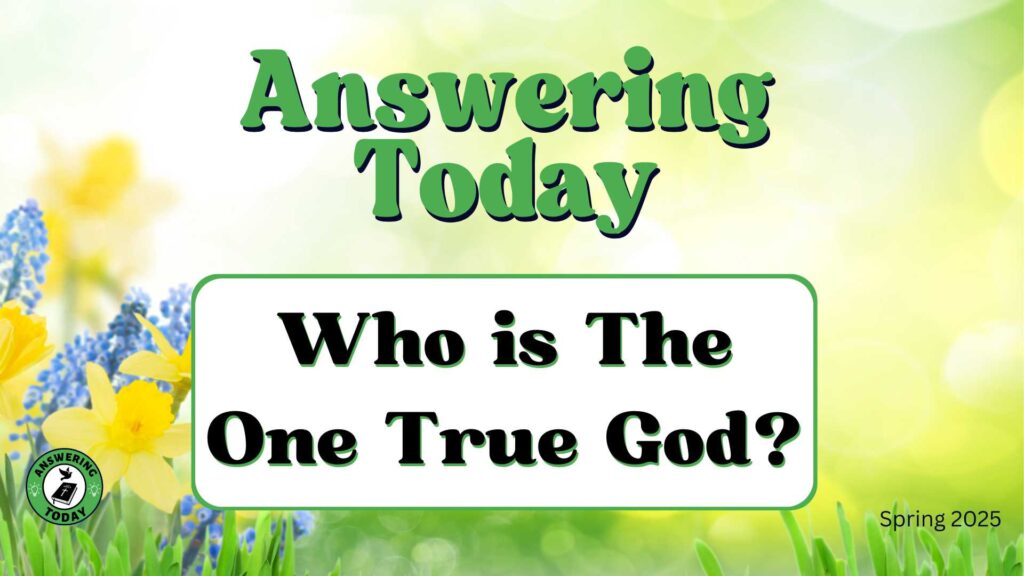QUESTION:
WHAT IS THE TRINITY?
ANSWER:
The Trinity is an essential Christian Doctrine that teaches that the one true God eternally exists as three distinct, co-equal, and co-eternal Persons—Father, Son, and Holy Spirit—united in essence yet unique in role.
Introduction: Understanding a Divine Mystery
The word Trinity does not appear in the Bible, yet the principle it represents is at the heart of Christian faith. The doctrine of the Trinity teaches that there is one God who exists in three distinct Persons: the Father, the Son (Jesus Christ), and the Holy Spirit. These three are not three gods, but one God—co-equal, co-eternal, and of the same divine essence.
When Jesus commissioned His disciples in Matthew 28:19, He told them to baptize “in the name of the Father and of the Son and of the Holy Spirit.” In that moment, He introduced not only their mission but also the importance of knowing the fullness of God. While John 17:3 defines eternal life as knowing the Father and Jesus Christ, the Great Commission expands this knowledge to include the Holy Spirit—implying that a relationship with the Triune God is essential to our faith.
1. There is Only One God
The Old Testament clearly affirms the oneness of God:
“Hear, O Israel: The Lord our God, the Lord is one!” – Deuteronomy 6:4
This was the foundational creed of the Israelites. Yet, scattered throughout the Hebrew Scriptures are subtle hints of plurality within the Godhead.
Examples:
-
Genesis 1:26: “Let Us make man in Our image.”
-
Genesis 3:22: “Behold, the man has become like one of Us.”
-
Isaiah 6:8: “Whom shall I send, and who will go for Us?”
The word for God in Hebrew, Elohim, is a plural form used with singular verbs—suggesting a plurality within unity.
2. The New Testament Reveals Three Distinct Persons
a. The Father is God
Jesus constantly referred to His Father as God.
- “Jesus spoke these words, lifted up His eyes to heaven, and said: “Father, the hour has come. Glorify Your Son, that Your Son also may glorify You, as You have given Him authority over all flesh, that He should give eternal life to as many as You have given Him. And this is eternal life, that they may know You, the only true God, and Jesus Christ whom You have sent.” – John 17:3
b. The Son is God
Jesus is not just the Son of God—He is God the Son.
-
John 1:1: “In the beginning was the Word, and the Word was with God, and the Word was God.”
-
John 20:28: Thomas said to Him, “My Lord and my God!”
-
Colossians 2:9: “For in Him dwells all the fullness of the Godhead bodily.”
c. The Holy Spirit is God
-
Acts 5:3–4: Lying to the Holy Spirit is lying to God.
-
2 Corinthians 3:17: “Now the Lord is the Spirit; and where the Spirit of the Lord is, there is liberty.”
-
He possesses attributes of God: omniscience (1 Corinthians 2:10–11), omnipresence (Psalm 139:7), and eternality (Hebrews 9:14).
3. One Essence, Three Persons
The early church summarized this mystery in this way:
God is one in essence but three in Person.
Each Person is fully God, not a part of God. Each is distinct but not divided.
To clarify:
-
The Father is not the Son.
-
The Son is not the Holy Spirit.
-
The Holy Spirit is not the Father. Yet, all three are fully and equally God.
4. Avoiding the Error of Modalism
One common heresy is Modalism—the idea that God is one Person who appears in three different forms or modes, like an actor wearing different masks. This view denies the simultaneous and eternal existence of the three Persons.
The Bible strongly contradicts this:
-
At Jesus’ baptism (Matthew 3:16–17): The Father speaks from heaven, the Spirit descends like a dove, and Jesus is baptized—all three Persons are present and active at once.
5. Human Analogies: One Yet Plural
No analogy is perfect, but some help our understanding:
-
Water analogy: Water can exist as ice, liquid, and steam—but this leans dangerously toward modalism because it cannot exist in all forms simultaneously.
-
Body-soul-spirit: A human being is one person but with three components—yet still not quite the same as the Trinity.
My best analogy may be the one given in marriage: “The two shall become one flesh” (Genesis 2:24).
This union illustrates how two distinct persons (husband and wife) are declared one in the eyes of God—still distinct, but united in essence and purpose. This is a glimpse, albeit imperfect, of the relational unity in the Trinity.
6. Historical Development and Creeds
The doctrine of the Trinity was not invented by the early Church—it was recognized, clarified, and defended in response to growing heresies and misunderstandings about the nature of God. While the early Christians worshiped the Father, the Son, and the Holy Spirit as God, the Church gradually formalized the doctrine through theological debates, councils, and creeds.
Tertullian (c. 155–220 AD) – First Use of “Trinity”
The North African theologian Tertullian was the first to use the Latin word Trinitas to describe the Christian understanding of God. In his writings, he articulated that the Godhead is “one substance and three persons” (una substantia, tres personae). Though his terminology was not yet standardized, his work laid the foundation for the later formulation of Trinitarian doctrine.
He wrote in Against Praxeas: “All are of one, by unity of substance; while the mystery of the dispensation is still guarded, which distributes the unity into a Trinity.”
The Council of Nicaea (325 AD) – The Deity of Christ Affirmed
The Council of Nicaea, convened by Emperor Constantine, was the first ecumenical council of the Christian Church. It was primarily called to address the heresy of Arianism, taught by Arius, a priest from Alexandria.
-
Arius taught that Jesus Christ, the Son of God, was a created being—not co-eternal with the Father. In his view, “there was a time when the Son was not.”
-
The Church saw this as a direct attack on the nature of Christ and the unity of the Godhead.
The council rejected Arianism and affirmed that:
-
The Son is “begotten, not made”
-
He is “of the same substance” (Greek: homoousios) as the Father
This was a groundbreaking moment: the Church confessed that Jesus is fully and truly God, co-eternal and co-equal with the Father.
The result was the Nicene Creed, which states:
“We believe in one Lord, Jesus Christ, the only-begotten Son of God… begotten, not made, being of one substance with the Father…”
The Council of Constantinople (381 AD) – The Deity of the Holy Spirit Affirmed
Though Nicaea defended the Son’s divinity, debate still remained about the Holy Spirit. Some groups, called Pneumatomachians (meaning “Spirit-fighters”), denied that the Holy Spirit was fully God.
The Council of Constantinople, convened under Emperor Theodosius I, expanded the Nicene Creed to affirm the full divinity and personhood of the Holy Spirit:
-
The Spirit is “the Lord and Giver of life”
-
He “proceeds from the Father”
-
He is to be “worshiped and glorified together with the Father and the Son”
Thus, the Niceno-Constantinopolitan Creed became the fuller version of what is now commonly called the Nicene Creed used in many churches today.
The Athanasian Creed (c. 5th–6th Century) – Full Definition of the Trinity
Though not written by Athanasius himself, this creed reflects his teachings and was developed in the Latin-speaking Church in the West. It is the most comprehensive statement of the doctrine of the Trinity in creedal form.
It begins:
“We worship one God in Trinity and the Trinity in Unity, neither confounding the Persons nor dividing the Substance.”
The Athanasian Creed teaches:
-
The Father is God, the Son is God, and the Holy Spirit is God.
-
They are not three Gods, but one God.
-
None is before or after, none is greater or lesser.
-
All three are co-equal, co-eternal, and uncreated.
This creed also addresses the incarnation of Christ, making it a fully Trinitarian and Christological document.
Final Thought: A God Who Is Relational
The Trinity shows us that God is not a solitary being, but a relational one. Love did not begin when He created us—God is love (1 John 4:8) because love has always existed between the Father, Son, and Holy Spirit.
To know God is to be invited into this eternal fellowship.
“Truly our fellowship is with the Father and with His Son Jesus Christ.” – 1 John 1:3
Let us worship the one true God—Father, Son, and Holy Spirit.
“The grace of the Lord Jesus Christ, and the love of God, and the communion of the Holy Spirit be with you all. Amen.” – 1 Corinthians 13:14



